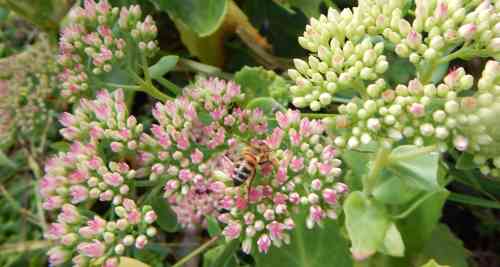How Many Bees In A Hive?
For a variety of reasons, beekeepers may want to know how many bees are in a hive.
On the other hand, curiosity may be the reason why the average person and hobby beekeeper would ask this question.
So, how many bees in a hive?.
The short answer is:
It could range between 20,000 and 60,000 bees or more, depending on the size of the hive and stage of development of the colony.
How To Count The Bees In A Hive
Given that there are thousands of small bees inside a hive, how do beekeepers count the number of bees?
There are several methods that may be used to estimate the approximate number of bees, but there may be variation, for example depending on the season and method used.

Weighing (hefting)
One method is to weigh (heft) the bee hive using scales. A single bee weighs about 0.1g, or 0.00022 pounds, therefore:
1 lb weight contains approximately 4,545 bees
1 kg weight contains approximately 10,000 bees
Estimating the number of bees on a frame
Another method is to estimate the number of bees on a frame full of honey bees, but this depends on the frame size.

The Langstroth hive is the most widely used. Below are estimations for full Langstroth and Dadant frames, according to published data1.
| Surface area of 3 frame types and expected bee density when frame is fully occupied by worker bees | |||
|---|---|---|---|
| Frame Type | Number bees per fully occupied side | Surface (cm2) per side of frame | Bees/cm2 |
| Deep Langstroth | 1215 | 880 | 1.38 |
| Langstroth | 1110 | 880 | 1.25 |
| Dadant | 1400 | 1130 | 1.24 |
Counting foragers
Another method is to count the number of worker honey bees leaving the hive during active foraging time.

Arizona University, College of Agriculture and Life Sciences came out with a formula to calculate the number of bees in a hive. It is based on the average number of bees leaving the hive to forage every day (about a third of the colony), the average number of flights per day by a single bee, and the amount of time spent foraging.
N = 3 x (f/0.0138), where:
N = number of bees in the hive
f = number of bees seen leaving the nest in one minute
If a beekeeper observes 150 bees leaving a hive in one minute, then there will be about 32,600 bees in the hive (150/0.0138 x 3).
They note that the value of 0.0138 is based on the average amount of time spent foraging for an average honey bee colony on an average day, and that this value will actually change considerably depending on the amount of food available, weather conditions and so on.

Why is it useful to know how many bees are in a have?
5 Reasons
1. Honey
Estimating the number of adult bees can help beekeepers have an idea about possible honey production capacity for the colony.
The honey production for any given number of bees increases as the
population of the colony increases. For example, while 4 colonies each
with 15,000 bees are producing 100 pounds of honey, 1 colony with
60,000 bees will produce more than 150 pounds of honey2.
2. Pollination
Some beekeepers sell pollination services. Obviously, having an idea about the number of workers (the most numerous bees within the colony) can give an idea about pollination capability, and how many hives will be required depending on the size of the field.
3. Colony health and monitoring
It can also serve to reassure the beekeeper that the colony is healthily producing more workers, and for example, comparing records before and following a swarm to estimate how many bees have been lost.
4. Scientific study
Knowing the number of bees in a hive can also be useful for scientists when setting up experiments, as this ensures all study groups are equal in size, to help ensure that fair comparisons can be drawn.
5. Curiosity!
We humans are simply curious, aren't we? The question may spring into our minds for no other reason than that we are a bit nosey. Well, why not?
References
1. Keith S Delaplane, Jozef van der Steen & Ernesto Guzman-Novoa (2013) Standard methods for estimating strength parameters of Apismellifera colonies, Journal of Apicultural Research, 52:1, 1-12, DOI: 10.3896/IBRA.1.52.1.03
2. More Honey From Bees by C. L. FARRAR.


